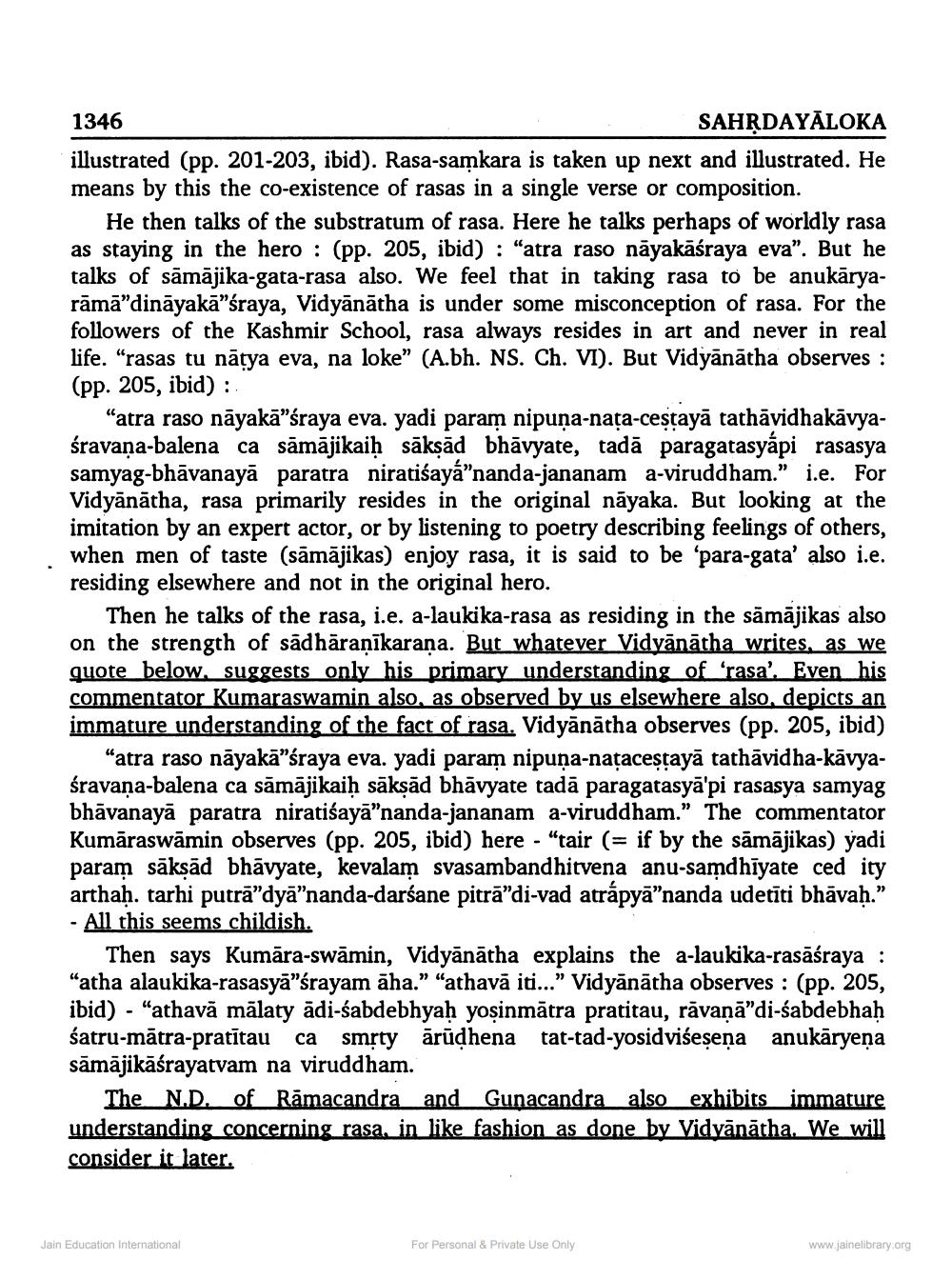________________
1346
SAHRDAYĀLOKA illustrated (pp. 201-203. ibid). Rasa-samkara is taken up next and illustrated. He means by this the co-existence of rasas in a single verse or composition.
He then talks of the substratum of rasa. Here he talks perhaps of worldly rasa as staying in the hero : (pp. 205, ibid): "atra raso nāyakāśraya eva". But he talks of sāmājika-gata-rasa also. We feel that in taking rasa to be anukāryarāmā"dināyakā"śraya, Vidyānātha is under some misconception of rasa. For the followers of the Kashmir School, rasa always resides in art and never in real life. “rasas tu nātya eva, na loke” (A.bh. NS. Ch. VI). But Vidyānātha observes : (pp. 205, ibid) :.
"atra raso nāyakā”śraya eva. yadi param nipuna-nata-cestayā tathāvidhakāvya śravana-balena ca sāmājikaiḥ sākṣād bhāvyate, tadā paragatasyápi rasasya samyag-bhāvanayā paratra niratiśaya"nanda-jananam a-viruddham.” i.e. For Vidyānātha, rasa primarily resides in the original nāyaka. But looking at the imitation by an expert actor, or by listening to poetry describing feelings of others, when men of taste (sāmājikas) enjoy rasa, it is said to be 'para-gata' also i.e. residing elsewhere and not in the original hero.
Then he talks of the rasa, i.e. a-laukika-rasa as residing in the sāmājikas also on the strength of sadhāranīkarana. But whatever Vidyānātha writes, as we quote below. suggests only his primary understanding of 'rasa'. Even his commentator Kumaraswamin also, as observed by us elsewhere also, depicts an immature understanding of the fact of rasa. Vidyānātha observes (pp. 205, ibid)
"atra raso nāyakā”śraya eva. yadi param nipuna-națacestayā tathāvidha-kāvyaśravana-balena ca sāmājikaiḥ sākṣād bhāvyate tadā paragatasyā'pi rasasya samyag bhāvanayā paratra niratiśayā"nanda-jananam a-viruddham.” The commentator Kumāraswāmin observes (pp. 205, ibid) here - "tair (= if by the sāmājikas) yadi param sākṣād bhāvyate, kevalam svasambandhitvena anu-samdhiyate ced ity arthaḥ. tarhi putrā"dyā”nanda-darśane pitrā"di-vad atrápyā”nanda udetīti bhāvah.” - All this seems childish.
Then says Kumāra-swāmin, Vidyānātha explains the a-laukika-rasāśraya : "atha alaukika-rasasyā”śrayam āha." "athavā iti...” Vidyānātha observes : (pp. 205. ibid) - "athavā mālaty adi-sabdebhyah yosinmātra pratitau, rāvanā"di-sabdebhah satru-mātra-pratītau ca smrty ārūdhena tat-tad-yosidvisesena anukāryena sāmājikāśrayatvam na viruddham.
The N.D. of Rāmacandra and Gunacandra also exhibits immature understanding concerning rasa, in like fashion as done by Vidyānātha. We will consider it later.
Jain Education International
For Personal & Private Use Only
www.jainelibrary.org




